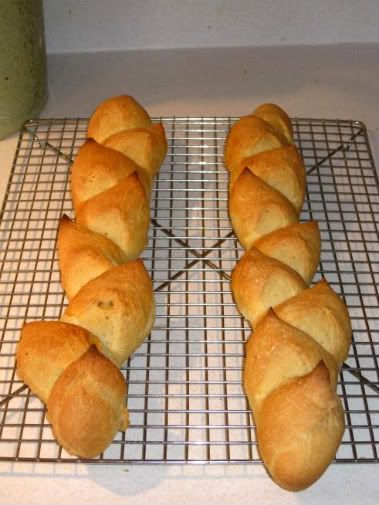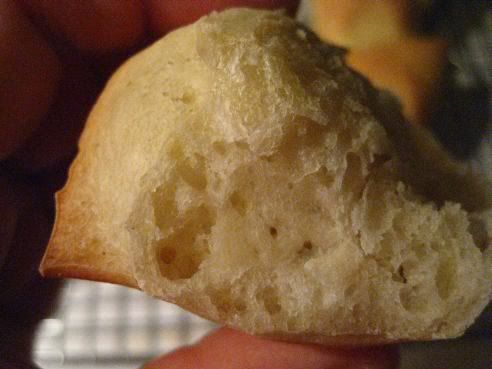I am not good at planning ahead - well, it's more appropriate to say that I'm not good at planning my dinners ahead. Which is why I have a terrible time with bread recipes that start a day ahead of baking time.
When I made my Baked Ziti I knew I wanted to bake some fresh bread, but I wasn't sure if it would be focaccia or baguettes. I was leaning toward focaccia, however I wanted to peruse a copy of Focaccia by Carol Field before I make another batch and I hadn't gotten it from my local library at that point. Baguettes it would be, but instead of the long loaf, I though I'd make them into some Epi.
Epis are baguettes cut to resemble the head of a stalk of wheat:
The problem now was finding a recipe that didn't start with an overnight poolish as most of them do - Bread Maker's Apprentice, The Bread Bible, Artisan Bread. Luckily, Bernard Clayton's New Complete Book Of Breads has one that doesn't require an overnight starter.
It also gave me a chance to try autolysing the flour, instant yeast and water. As per Rose Levy Beranbaum's The Bread Bible entry on autolyse, because I was using instant yeast and resting it for only 20 minutes, I added the yeast to all the water and flour in the recipe. I'm not sure I did it correctly, but it cut my kneading time down to 2 minutes instead of 10 minutes.
I halved the recipe to make two epis.
Yield: 4 baguettes, boules, or couronnes
Bernard Clayton Jr, The New Complete Book of Breads
6 cups bread or unbleached flour, approximately
2 packages dry yeast (4 1/2 tsps)
2 1/2 cups hot water (120-130 degrees F)
2 teaspoons each salt and water
Baking Sheet or Pans: 1 baking sheet, teflon or greased and sprinkled with cornmeal, or 4 baguette pans, greased.
By Hand or Mixer: (10 mins)
The early part of this preparation, beating a batter, can be done by an electric mixer. However, don’t overload a light mixer with this thick batter. If by hand, stir vigorously for an equal length of time.
Measure 3 or 4 cups of flour into the mixing bowl and add the yeast and hot water. The mixer flat beater or whisk should run without undue strain. The batter will be smooth and pull away from the sides as the gluten develops. It may also try to climb up the beaters and into the motor. If it does, push it down with a rubber scraper. Mix for 10 minutes. When about finished, dissolve the salt in the water and add to the batter. Blend for 30 seconds or more.
Kneading (10 mins.):
If the machine has a dough hook, continue with it and add additional flour, 1/4 cup at a time, until the dough has formed under the hook and cleans the sides of the bowl. If it is sticky and clings, add sprinkles of flour. Knead for 10 minutes.
If by hand, add additional flour to the beaten batter, 1/2 cup at a time, stirring first with a utensil and then working by hand. When the dough is shaggy but a solid mass, turn onto a work surface and begin kneading with an aggressive push-turn-fold motion. If the dough is sticky, toss down sprinkles of flour. Break the kneading rhythm occasionally by throwing the dough down hard against the countertop – an excellent way to encourage the development of the dough.
First Rising (2 hours):
Place the dough in a large greased bowl, cover with plastic wrap, and leave at room temperature for 2 hours. The dough will more than treble in volume – and may even be pushing against the plastic covering.
Second Rising (1 1/2 hours):
Turn back the plastic wrap and turn the dough onto the work surface to knead briefly, about 3 minutes.
Return the dough to the bowl and re-cover with wax paper. Allow to rise to more than triple its volume, about 1 1/2 hours.
Shaping (10 mins)
The dough will be light and puffy. Turn it onto the floured work surface and punch it down. Don’t be surprised if it pushes back, for it is quite resilient.
Divide the dough into as many pieces as you wish loaves. One-quarter (10 oz) of this recipe will make a baguette 22? long and 3? to 4? in diameter.
Allow pieces of dough to rest for 5 minutes before shaping.
To make an epi, see below in baking directions.
For boules or round loaves, shape the pieces into balls. Place in cloth-lined baskets (bannetons) or position directly on the baking sheet. For baguettes, roll and lengthen each dough piece under your palms to 16? to 20? , and 3? to 4? in diameter. Place in a pan or on a baking sheet or in the folds of a long cloth (couche).
This loaf’s characteristic couronne or “crown” can be made in several ways. One is to flatten the piece of dough, press a hole through the center with your thumb, and enlarge the hole with your fingers. Another is to roll a long strand 18? to 24? and curl into a circle, overlapping and pushing together the ends. Yet a third way is to take 2 or 3 shorter lengths of dough and join them together in a circle, not overlapping top and bottom but pressing the ends together side by side into a uniform pattern – this one will be irregular but attractive.
Third rising (1 hour)
Cover the loaves with a cloth, preferably of wool, to allow air to reach the loaves and to form a light crust. Leave at room temperature until the dough has risen to more than double its size, about 1 hour.
To make an epi: Shape the dough into baguettes and follow rising directions. Right before placing in the oven follow these directions from Bread (Eric Treuille and Ursula Ferrigno):
Hold a pair of scissors almost horizontally to cut a Baguette into the Pain d’Epi variation. Cut about three-quarters of the way through the dough, leaving about 2 inches between each cut. Gently place the flaps to alternate sides.
 |
| Copyright Bread (Eric Treuille and Ursula Ferrigno) |
Before preheating the oven to 450 degrees F (very hot) 20 minutes before baking, place a broiler pan on the floor of the oven or bottom rack so it will be there later. Five minutes before baking, pour 1 cup hot water into the hot pan. Be careful of the burst of steam – it can burn. I use a long-handled cup to reach into the oven when I pour.
Baking: (450 degrees F/25-30 mins.)
Carefully move the loaves in baskets and in couches to the baking sheet. Make diagonal cuts down the lengths of the long loaves and tic-tac-toe designs on the boules.
Place on the middle shelf of the oven.
The loaves are done when a golden brown, 25 to 30 minutes. Turn one loaf over and if the bottom crust sounds hard and hollow when tapped, the loaf is done.
(If using a convection oven, reduce heat 50 degrees.)
Instead of the steam pan, I will usually spray my bread with a plant mister before placing in the oven to bake. I have found in general it gives me the same results as a steam pan. However, I wouldn't spray a loaf that was dusted in flour.
Now this is the point where I tell you that these epi were a mistake - not a "I shouldn't have made epi bread!" mistake, more of a "I shouldn't have used this recipe.." mistake.
What I wanted were nice fat baguettes that give beautiful long ears like this previous batch I made last autumn using a different recipe:
 | |
| Epi, November 2010 |
The next time I will again use the recipe from Bread by Eric Treuille and Ursula Ferrigno:
Baguette
makes 2 baguettes
2 1⁄2 tsp dry yeast
1 1⁄4 cups water
3 3⁄4 cups bread flour
1 1⁄2 tsp salt
Sprinkle the yeast into 1 1⁄4 cups of the water in a bowl. Let stand for 5 minutes; stir to dissolve. Mix the flour and salt in a large bowl. Make a well in the center and pour in the dissolved yeast.
Use a wooden spoon to draw enough of the flour into the dissolved yeast to form a soft paste. Cover the bowl with a dish towel and let “sponge” until frothy and risen, 20 minutes.
Mix in the flour and add the remaining water, as needed, 1 tablespoon at a time, to form a soft, sticky dough.
Turn out onto a lightly floured work surface. Knead until soft, smooth, and supple, about 10 minutes. Try to avoid adding extra flour while kneading the dough.
Put the dough in a clean bowl and cover with a dish towel. Let rise until doubled in size, about 1 1⁄2 hours.
Punch down, re-cover, and let rise for 45 minutes longer. Punch down again, re-cover, and let rise until doubled in size, about 45 minutes.
Divide the dough into two equal pieces and shape into two baguettes, each about 12 inches in length. Place on a floured baking sheet or in a floured baguette tray; cover with a dish towel. Proof until doubled in size, about 50 minutes.
Cut several diagonal slashes across the top.
Bake in the preheated oven for 20–25 minutes, until golden and hollow sounding when tapped underneath. Cool on a wire rack.
Still submitting to Yeastspotting..
I have to point out, though, that the pain ordinare tasted delicious!!




No comments:
Post a Comment